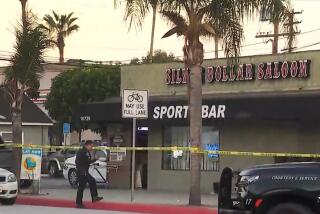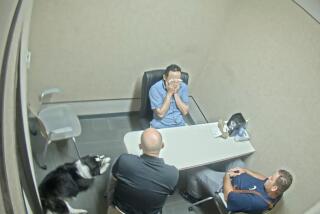FBI Probes Man’s Killing in Police Raid
- Share via
Federal authorities have opened an investigation into the El Monte Police Department’s fatal shooting of a 61-year-old grandfather during a narcotics raid in Compton, officials said Monday.
Assistant U.S. Atty. Mike Gennaco said his office asked the FBI to open a probe to see if Mario Paz’s civil rights were violated by the El Monte officers who, during a nighttime raid, shot off the locks to his home and then shot him in the back.
The police say an officer feared that Paz was armed or was reaching for a weapon--characterizations disputed by the family. El Monte police had been looking for an alleged drug dealer who had used Paz’s address. Police have since said they had no information to tie Paz or his family to drug trafficking and still do not have any information or evidence of wrongdoing.
The Los Angeles County Sheriff’s Department, as is standard in many officer-involved shootings, is investigating the incident.
The new federal investigation is a criminal probe, and Gennaco said his office wants to determine “whether or not excessive force was used.”
Victim’s Daughter Praises Action
Opening the probe does not guarantee prosecution. Gennaco, the head of the civil rights division of the U.S. attorney’s office, could recall the prosecutions of only six officers during the past 4 1/2 years despite more than two dozen civil rights investigations annually.
Still, the news was hailed by Paz’s family.
“That’s great,” said Maria Derain, one of Paz’s six children. “The faster questions are answered, the better.
“They’ll definitely press the issue and they need to get to it right away,” said Derain, who added that she had been so shaken by her father’s Aug. 9 slaying that she managed to return to work only on Monday. “We’ve been really devastated.”
Assistant El Monte Police Chief Bill Ankeny said he was not surprised to hear the federal government was probing the killing, saying it commonly examines high-profile police shootings.
“It doesn’t surprise me because, so far, for the most part, only one side has come out,” Ankeny said. “Consequently, there’s nothing come out in the defense of the officers.”
The U.S. government is not alone in asking questions about the incident.
Alberto Aviles, a spokesman for the Mexican Consulate, said the family of Paz, a Mexican national, asked consulate officials to monitor the case.
“We’re concerned by what the family told us, when they say it wasn’t necessary for this man to be shot and killed,” Aviles said. He said El Monte police had promised to keep the consulate briefed on the probe and that it was too early to know exactly what happened.
The shooting stems from a narcotics investigation by El Monte police into Marcos Beltran Lizarraga. El Monte police searched a home in Chino, with Lizarraga present, Aug. 6 and found $75,000 in cash, according to a search warrant affidavit.
Detectives next went to Lizarraga’s home in La Puente and found 400 pounds of marijuana and three loaded assault rifles, the affidavit states. Then, after arresting Lizarraga, El Monte police obtained a warrant to search the Paz home, an address they found on Lizarraga’s cellular phone bills and driver’s license.
“It is [my] opinion that Lizarraga . . . is currently using the Compton location to house marijuana and/or U.S. currency,” El Monte Det. George Mendoza wrote in the affidavit.
Police went to the Paz address to “further the investigation,” Ankeny said. “We don’t always do search warrants to find people. We sometimes do them to find further evidence and proceeds.”
But police found more than half a dozen people in the single-story, blue stucco home when a SWAT team shot off the front and rear door locks, tossed a “flash-bang” grenade and stormed inside.
In one bedroom, Mario Paz, grandfather of 14, lay sleeping.
Paz’s family says he was terrified that he was being robbed, and lying on the bed was the $10,000 in life savings he had withdrawn from a Tijuana bank earlier that day.
The Sheriff’s Department has provided three different explanations for why Paz was shot. The first explanation was that El Monte officers believed Paz to be armed. The second, offered Wednesday by a sheriff’s homicide investigator, was that the officer who shot Paz thought he saw him reaching for his gun--a suggestion hotly disputed by the family.
The current explanation, in a statement Thursday, is that Paz was shot when he began to reach for a nearby drawer where police say they found guns.
Man Was Shot in the Back, Coroner Says
Paz was shot twice in the back and died a short time later, according to the county coroner’s office. His wife was hustled outside in her panties, a towel and plastic handcuffs, where she and other relatives were held for questioning, then released.
Police found three pistols and a .22-caliber rifle in the home, which the family said were used for protection. They also took the $10,000 as evidence. El Monte officers initially said they would try to have the cash forfeited in a civil procedure as ill-gotten gains. Police now say that if they can’t develop information that the money came from narcotics trafficking, it will be returned to the family.
Gennaco, of the U.S. attorney’s office, said he has been “tracking” the case for some time. He would not say how his unit became aware of the shooting.
Perhaps the highest-profile civil rights probe in Los Angeles was the prosecution of four Los Angeles Police Department officers for the 1992 beating of motorist Rodney King.
Other probes include the recent shootings of a mentally handicapped homeless woman, Margaret Mitchell, in Hancock Park, and Tyisha Miller, who was shot in her car by Riverside police.
Gennaco said his office, which works with the FBI probing a wide variety of alleged civil rights cases--from racial attacks by Antelope Valley skinheads to police misconduct--has “a low bar for investigations to make sure we don’t miss any cases.”
Conversely, he said, the office “has a very high standard of proof.”
More to Read
Sign up for Essential California
The most important California stories and recommendations in your inbox every morning.
You may occasionally receive promotional content from the Los Angeles Times.










